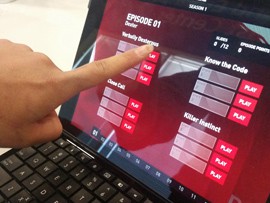Cronkite News has moved to a new home at cronkitenews.azpbs.org. Use this site to search archives from 2011 to May 2015. You can search the new site for current stories.
New tech trend: Gamification injects gaming into everyday life
Have you ever watched “The Walking Dead” while following the bonus features on your tablet? Or had a computer program train you how to do something at work? What about taking a quiz on Facebook or BuzzFeed?
If so, you’ve been “gamified.”
Schools, companies and other organizations are using gamification to connect teachers, students, workers and other audiences to information and advertising.
“When you look at the Internet, initially it was how do you create rules for everyone to connect with each other?” said Ajay Vinze, associate dean of international programs at the W. P. Carey School of Business at Arizona State University. “The next frontier, going forward from here, is this notion of gamification.”
Definitions of gamification vary, but it’s generally the idea of using video-game – or even board game – elements to help people reach an objective: solving a problem, training employees or marketing companies or products.
Fifty percent of corporate innovations will be ‘gamified’ by the end of 2015, according to Connecticut-based technology research firm Gartner Inc.
A couple Arizona companies are helping the industry grow through their own custom-built gamification software options.
“Gamification is a way to communicate effectively with a chronically distracted generation,” said Darren Steele, with Tempe-based gamification company Mindspace. “We need to find different ways to communicate with them, folks that are used to Netflix and essentially can opt-out of any unwanted messaging. It’s not just entertainment and distraction, but incremental value and the intrinsic value that can be found in games.”
Phoenix-based Fiero works with clients to build all its gamification products from scratch, said Jason Edwards, the agency’s principle and strategy director.
Edwards said gamification isn’t new. Airline mileage programs have used the concept for decades. But he said within five years, gamification will become a household word.
How can you tell the difference between a video game and a gamified experience?
“We call that opacity, the extent to which an experience feels like a game and has the graphics, sounds, feedback systems that are game-like,” Steele said. “For a bank or a law firm, it isn’t going to feel very much like a game. For second-screen experience like for a TV show or a movie, it will feel a lot like a game.”
Gamified experiences can be as simple as points, badges and leaderboards. More complicated ventures could include creating avatars and earning points for interacting with web pages.
Even some mainstream video games could be considered part of this new industry. Telltale Games, a California-based company, has produced choose-your-own adventure-esque titles for AMC’s “The Walking Dead” and HBO’s “Game of Thrones” that are just as much interactive video games as they are marketing tools.
But gamification goes far beyond entertainment.
Companies with call centers use the tool to train employees faster and more cost effectively. Edwards said this segment is getting larger.
“The biggest growth opportunity is in corporate management and corporate engagement,” Edwards said. “This is largely because you have a user base that is going to interact probably at a deeper level than you are going to get with most marketing or promotional things.
“Gamification has its greatest value when you create an environment where someone is interacting at that deeper level.”







